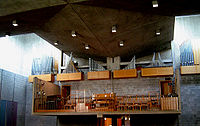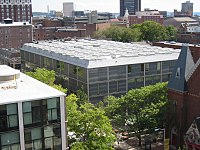
Louis Kahn
Louis Isadore Kahn (born Itze-Leib Schmuilowsky; March 5 [O.S. February 20] 1901 – March 17, 1974) was an Estonian-born American architect[2] based in Philadelphia. After working in various capacities for several firms in Philadelphia, he founded his own atelier in 1935. While continuing his private practice, he served as a design critic and professor of architecture at Yale School of Architecture from 1947 to 1957. From 1957 until his death, he was a professor of architecture at the School of Design at the University of Pennsylvania.
For the American computer scientist, see Louis B. Kahn. For the French Jewish admiral, see Louis Kahn (admiral).
Louis Kahn
February 20, 1901
March 17, 1974 (aged 73)
American
Architect
Center of Philadelphia, Urban and Traffic Study
Kahn created a style that was monumental and monolithic; his heavy buildings for the most part do not hide their weight, their materials, or the way they are assembled. He was awarded the AIA Gold Medal and the RIBA Gold Medal. At the time of his death, he was considered by some as "America's foremost living architect."[3]
Awards and honors[edit]
Kahn was elected a Fellow in the American Institute of Architects (AIA) in 1953. He was made a member of the National Institute of Arts and Letters in 1964, the year he was awarded the Frank P. Brown Medal. In 1965, he was elected into the National Academy of Design as an Associate Academician, and received an honorary Doctor of Fine Arts from Yale University.[20] He was made a member of the American Academy of Arts and Sciences in 1968 and awarded the AIA Gold Medal, the highest award given by the AIA, in 1971, and the Royal Gold Medal by the Royal Institute of British Architects (RIBA), in 1972.[21][22] In 1971, he received the Golden Plate Award of the American Academy of Achievement.[23]
Personal life[edit]
Kahn had three children with three women. With his wife Esther he had a daughter, Sue Ann.[3] With Anne Tyng, who began her working collaboration and personal relationship with Kahn in 1945, he also had a daughter, Alexandra. When Tyng became pregnant in 1953, to mitigate the scandal, she went to Rome, for the birth of their daughter.[24] With Harriet Pattison, he had a son, Nathaniel Kahn. Anne Tyng was an architect and teacher, while Harriet Pattison was a pioneering landscape architect.[25] Kahn's obituary in The New York Times, written by Paul Goldberger, mentions only Esther and his daughter by her as survivors.[3]
Documentary[edit]
In 2003, Nathaniel Kahn released a documentary about his father, My Architect: A Son's Journey. The Oscar-nominated film provides views and insights into Kahn's architecture while exploring him personally through his family, friends and colleagues.[26]
All dates refer to the year project commenced
In popular culture[edit]
Kahn was the subject of the 2003 Oscar-nominated documentary film My Architect: A Son's Journey, presented by Nathaniel Kahn, his son.[26] Kahn's complicated family life inspired the "Undaunted Mettle" episode of Law & Order: Criminal Intent.
In the 1993 film Indecent Proposal, character David Murphy (played by Woody Harrelson), referenced Kahn during a lecture to architecture students, attributing the quote "Even a brick wants to be something" to Kahn.
Pulitzer Prize-winning composer Lewis Spratlan, with collaborators Jenny Kallick and John Downey (Amherst College, class of 2003), composed the chamber opera Architect as a character study of Kahn. The premiere recording was due to be released in 2012 by Navona Records.
In Showtime's Billions (Season 4, Episode 6), Taylor Mason and Wendy Rhoades meet at the Franklin D. Roosevelt Four Freedoms Park and discuss Kahn's genius and his relationship with his estranged son.[40]












